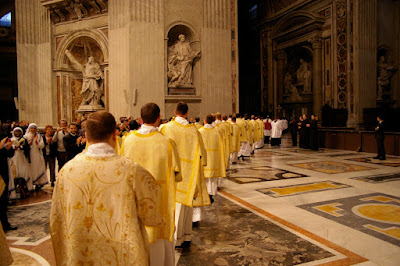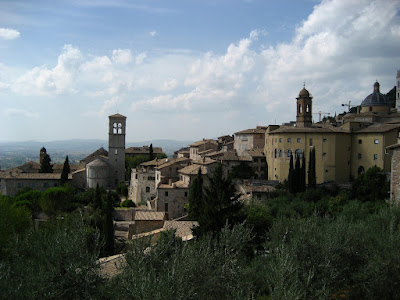
Last Sunday I attended another Mass at Saint Peter's Basilica. As you might guess, it never gets old.
This Mass marked the close of the 12th ordinary general synod of bishops, which met for the last three weeks to discuss "The Word of God in the Life and Missin of the Church." Established at Vatican II by Christus Dominus, a synod of bishops is a gathering of bishops from around the world that acts as an advisory body to the pope on a particular matter. Unlike a full ecumenical council, where all bishops of the world attend, a synod is attended by only a few representative bishops from each nation. This year the U.S. had four representatives: Cardinal Francis George of Chicago; Cardinal Daniel DiNardo of Galveston-Houston; Archbishop Donald Wuerl of Washington, D.C.; and Bishop Gerald Kicanas of Tuscon. In total, some 250 bishops from 110+ countries attended the synod.
As you can see from the title of the synod above, the theme was quite broad. Specifically, the bishops met to discuss how the Church, some 40 years after Dei Verbum (Vatican II's great pronouncement on revelation and Scripture which called for a new attention to Scripture), was doing in its post-Vatican II efforts to help the faithful become more educated about Scripture, be inspired to actually read it, and view it as an essential means of encountering God in daily life. It was meant to be an honest appraisal of how the Church can be more effective in announcing the Gospel to all peoples, especially her own, and in bringing them to a new appreciation for its relevance in daily life.
This Mass marked the close of the 12th ordinary general synod of bishops, which met for the last three weeks to discuss "The Word of God in the Life and Missin of the Church." Established at Vatican II by Christus Dominus, a synod of bishops is a gathering of bishops from around the world that acts as an advisory body to the pope on a particular matter. Unlike a full ecumenical council, where all bishops of the world attend, a synod is attended by only a few representative bishops from each nation. This year the U.S. had four representatives: Cardinal Francis George of Chicago; Cardinal Daniel DiNardo of Galveston-Houston; Archbishop Donald Wuerl of Washington, D.C.; and Bishop Gerald Kicanas of Tuscon. In total, some 250 bishops from 110+ countries attended the synod.
As you can see from the title of the synod above, the theme was quite broad. Specifically, the bishops met to discuss how the Church, some 40 years after Dei Verbum (Vatican II's great pronouncement on revelation and Scripture which called for a new attention to Scripture), was doing in its post-Vatican II efforts to help the faithful become more educated about Scripture, be inspired to actually read it, and view it as an essential means of encountering God in daily life. It was meant to be an honest appraisal of how the Church can be more effective in announcing the Gospel to all peoples, especially her own, and in bringing them to a new appreciation for its relevance in daily life.
The process for the synod began more than two years ago, when the Vatican sent out a lineamenta, a set of guidelines meant to establish the basic theme for the synod and to elicit input from the bishops around the world about which specific issues to address. The bishops responded over the next year with their own ideas and, earlier this year, the Vatican published the instrumentum laboris, or the working document which served as the text and framework for the synod. During the actual three week sessions, the bishops met to discuss various parts of the instrumentum and made certain propositions for the pope to consider. These were narrowed down by vote to 55 approved recommendations, which were then passed along to the Holy Father for his review. In the next year or so, Benedict will then write a document which that will be the instructive result of the synod, accepting or rejecting the bishops' proposals and calling for new measures or offering new insights on the synod's general theme.
 The Pope loves babies, especially when they're held by nuns.
The Pope loves babies, especially when they're held by nuns.A myriad number of topics were reportedly touched on by the bishops at the synod, but certain key issues were continuously raised, including: a call for the Bible to be made more available in third world countries through accurate translations into minor languages; a call for a renewal of preaching, specifically that homilies be based more on the Scriptural readings of the day while not being neglectful of incorporating catechetical elements when possible; an appeal for efforts to be made at the diocesan and parish level to stress the importance of Scripture and its daily use by the faithful; a new appeal for the Word of God to be explicitly proclaimed by the Church through its service to others, especially the poor and underprivileged; and an interesting and controversial new proposal that women be formally instituted as lectors, i.e. readers of Scripture at Mass. Women already serve as lectors in many first world countries, including the U.S., but presently only men studying for the priesthood are formally instituted as lectors. You can find more information about the 55 propositions here. A summary of the final message of the synodal fathers is found here, and here is the Pope's homily at the closing Mass.
The Mass itself was quite powerful to be present for. I was fortunate enough to be actually on the aisle -- it's not so important how far up you get as how close to the aisle you are -- so I had a full view as the two hundred plus bishops and cardinals processed in, followed by the Holy Father. The Mass was very international, as you might expect, with readings in all of the major languages of the West, as well as Russian, Greek, Hindi, and Arabic. I was able to follow along fairly well with the Pope's homily. As you might read in the link above, it is, like all of his work, at once learned and practical and I very much look forward to his more definitive statements when they come out next year.
On Sunday evening, the four synodal fathers of the U.S. Church gave the NAC student body a presentation on the synod and answered questions. It was great to hear their viewpoints on many of the issues I outlined above, as well as to hear their thoughts on what topics the eventual statement from the Holy Father might reflect. Each of the bishops stayed here at the NAC during their time here, and so it was great to see them in the hallways or at meals over the last month, and thus to feel, in some way, connected to the spirit of the synod. It was very gracious of them to take time out of their busy schedules to fill us in on what this great ecclesial event had been all about. Certainly the theme is most important to our lives as Christians.
* * *
Happy Halloween to all of you back in the States. It was always one of my favorite holidays as a kid, and even today I enjoy reading a little E.A. Poe this time of year or watching an old horror classic. This year, I had to content myself by watching online what has become a yearly Halloween tradition. However you spend it, hope you enjoy yourself! 


















